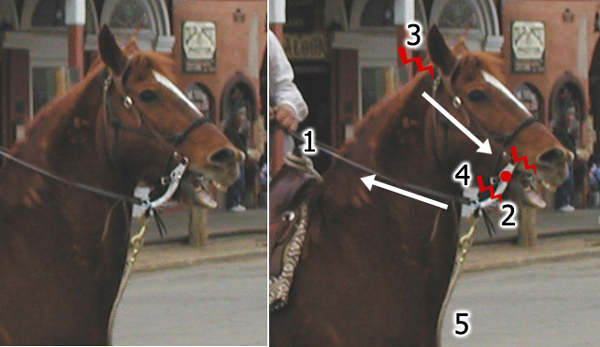
Although shanked curb bits are an extremely popular bit type in the USA, they are probably one of the most misunderstood pieces of horse tack. Most riders know a curb bit is strong, and so it is often put on horses that are less trained. But as this diagram shows using a curb bit to control a horse can actually create so much pain that the horse will react, possibly with dangerous results, to the pain inflicted by the curb bit. When the reins of a curb bit are tightened, they do not just send a cue to the horse’s mouth to slow down, they painfully affect several sensitive areas of the face:
1. To start the chain of actions in this curb bit diagram, the reins are first tightened. This can be a short yank or a steadier pull like that a beginner or intermediate rider would try using to slow a horse or control behavior.
2. A curb bit works as a simple lever. There is a fulcrum and when one extension off the fulcrum is pulled, the other extension is forced in the other direction. In this case, when the bottom of the shank, where the reins attached, go back, the upward projections of the bit that attach to the headstall (this part is called the "purchase") and the port (bend in the mouthpiece of the bit) are pulled forward. At this point, three things happen:
Upper red lightning bolt: The port, which was at rest sitting parallel to the horse’s tongue, rolls forward and mashes into the roof of the horse’s mouth. Because of the leverage from the lever, the pressure with which the port is pressed into the sensitive pallet is exponentially greater than the weight the rider feels in the reins.
3. As the purchase (where the headstall connects) rolls forward in response to the backward pull on the curb reins, the headstall is pulled down on the poll of the horse. The poll is one of the most sensitive areas of the horse’s body, so this pressure – again, exponentially greater than the pull the rider feels they are exerting – is extremely painful.
4. As the purchase rolls up and forward, the strap underneath the chin, called the curb strap or chain, is pulled up with it and tightens like a vice on the sensitive tissues, pinning the horse’s flesh between a tight chain/strap and bone. Wide curb straps are slightly more gentle, while thin chains or chains that do not lay flat are the most severe.
5. The natural reaction to this much pain being strategically exerted on the most sensitive areas of a horse’s face are for the horse to lift their head high, which makes the curb bit less effective and less painful. Thus, this rider’s addition of another common incorrectly used piece of tack. The strap leading from the rope halter down (affixed to the girth) is called a tie down. The proper use of a tie down is to provide support for a gaming performance horse, but many uneducated riders use them to mask the pain reactions of curb bit usage. By strapping the horse’s head down (the thinner the noseband – like this rope one- the more painful) the horse cannot escape the action of the curb bit and is forced to submit.
As you can see, holding curb reins with even a little snugness can be intensely painful for most horses. Horses usually deal with the pain shown in this curb bit diagram by acting out or dulling down. Many training problems of a huge variety are actually natural responses to the pain of a improperly used curb bit- what human would want to be an athletic performer- or even just go for a quite walk in the woods- if they were in pain? Other horse’s nerves literally deaden due to the pain, and while they are somewhat safer to ride, without serious retraining and time off they are incapable of responding to the cues needed for real performance.
A curb bit is not a bad bit, but is a bit best left to advanced riders and horses trained to respond to seat, leg, and changes in the drape of the reins. (That is how a curb bit is designed to be used)
If you are a rider who frequently rides with contact in their reins, consider switching to a snaffle bit. A snaffle bit is designed to be ridden with contact and is not painful for a horse like a misused curb bit is. There are varying types of snaffles which will provide sharper or gentler corrections, speak to a horse trainer to determine which snaffle bit might be a good fit for your horse.

Leave a Reply